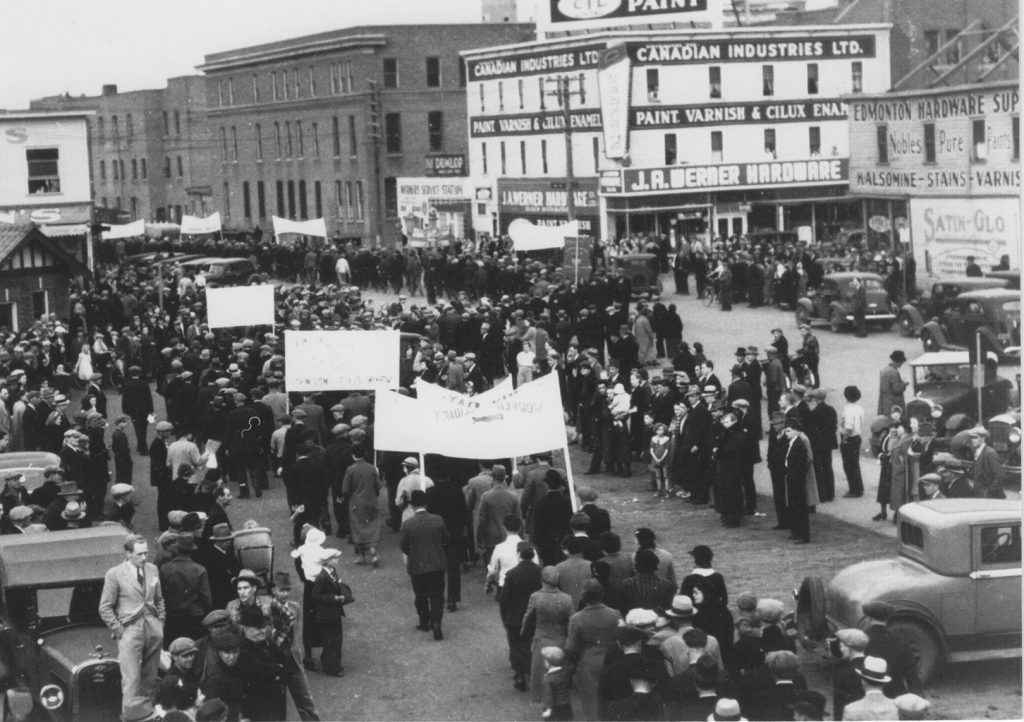by Kirk Niergarth
(Assistant Chair and Associate Professor, Humanities Mount Royal University)

May Day demonstrations in Alberta date back to the 1920s, but it was really in the Depression years that they grew in size and significance. To tell you a bit more about what happened here in Calgary on this day eight decades ago, I have relied mainly on the records of the most diligent chroniclers of the Canadian left of that era: the RCMP.
In 1930, there were only a few dozen card-carrying Communists in Calgary, but there were many socialists of various hues and broad-based sympathy with left-wing ideas. When the Depression swelled the number of unemployed – and when Communists seemed to be the only group interested in helping them organize – the number of sympathizers grew.
Calgary police, however, were not sympathetic. When the Communist-led parade of 1930 swelled to include at least 1000 marchers, the police broke up the demonstration with force. Four of the parade leaders were arrested, presumably for the crime of impeding the swing of a baton with their skull.
The following year, hoping to avoid similar police violence, the organizers applied for a parade permit. When this permit was denied, 2000 people congregated on May Day in front of City Hall demanding that the mayor meet with a delegation and reconsider. Mayor Andy Davison did host a meeting but didn’t reverse the decision. The leaders told the crowd to disperse. When it began to do so, the sizable police presence mistook the movement for a non-permitted parade which was the only excuse they needed to charge the crowd, tearing banners and, again, swinging batons. 7 arrests were made for the crime of enduring police brutality.
As the Depression deepened and the ranks of the unemployed swelled, demonstrations in the city and across the country became larger. May Day came early to Calgary on 25 April 1934 when a group of veterans split off from an enormous parade on Macleod Ave to engage in a confrontation with police in the riot known as “The Battle of Mission Hill.” I’m not sure what, if anything happened on the first of May that year – probably fundraising for bail money!
My favourite RCMP account of a Calgary May Day dates from 1935 when they were pleased to report that only 700 people marched in the city – this in a year that 10,000 marched in Vancouver, 5,000 in Winnipeg and Montreal. Toronto had 20,000 on the lawn of Queen’s Park in the afternoon and Maple Leaf Gardens packed in the evening.
So, only 700 in Calgary – except, the Mountie had to admit, the numbers might have been depressed by the fact that the parade coincided with a blizzard (some things about Calgary haven’t changed – yes, it is beautiful today, but we all know we could be shovelling tomorrow). Those 700 who braved the weather congregated in the Victoria Pavillion after the march and heard speeches from the socialist Alderman Robert Parkyn and the Communist representative Pat Lenihan who would be elected to City Council in 1938.
Organizers in Edmonton had the good sense to delay their parade until the weather improved – their May Day that year was on 4 May,1935 and, in the words of the RCMP “about 2000 marched behind a banner hailing the Communist International while thousands lined the streets.” There were also signficant parades in towns such as Myrnam, Nordegg, and Blairmore Alberta that year, and you can bet there were others.
But what were these parades like? The description of the 1936 Edmonton parade gives a sense of the theatricality of the spectacle: That year, at the head of 1700 marchers, five people pulled a wagon loaded with what purported to be bags of money (they were actually full of sawdust). On top of this pile of loot were three figures dressed as Capitalism, Fascism and War. (The latter equipped with an imitation machine gun.) Behind the wagon walked pall bearers of a coffin labelled “Capitalism” and behind them came grave diggers under a banner “People’s Unity: the Grave Digger of Capitalism.” The parade ended in Market Square where the marchers were addressed by Communist and CCF speakers. Then there were evening dances in various labour temples and halls.
Perhaps Calgary’s biggest May Day parade came in 1938. The city was in the midst of another relief strike. 17 of the strike’s leaders had been arrested and, out on bail, they led a parade of 3400 past crowds lining the streets. According the the Mounties, a wide variety of organizations were represented with a “profusion” of banners and slogans. 200 children of the Young Pioneers marched and “sang the Internationale even more lustily than their elders.”
These parades were only a part of a much larger movement in these years that won some significant concessions for the poor and unemployed of Alberta. More significantly, they convinced thousands of those dispossessed by capitalism that an alternative was possible and would only be realized through organization and resistance. They were not, as things turned out, the grave diggers of capitalism, but their message about the potential of the peoples’ unity resonates with us today.
